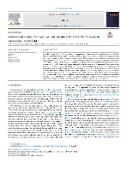A numerical model of convective heat transfer in Titan's subsurface ocean

Datum vydání
2022Publikováno v
IcarusRočník / Číslo vydání
376 (April)ISBN / ISSN
ISSN: 0019-1035Metadata
Zobrazit celý záznamKolekce
Tato publikace má vydavatelskou verzi s DOI 10.1016/j.icarus.2021.114853
Abstrakt
It has been suggested that the long-wavelength topography of Titan is related to lateral variations in the heat flux from the ocean. Recent studies of the heat transfer in Titan's ocean agree that the time-averaged heat flux can vary in latitude by tens of percent, but they predict different distributions of heat flux anomalies at the upper boundary of the ocean. In order to clarify this issue, we perform 115 numerical simulations of thermal convection in a rotating spherical shell, varying the mechanical boundary conditions and dimensionless input parameters (Rayleigh, Ekman and Prandtl numbers) by at least one order of magnitude. The results of the simulations are examined in terms of the modified transitional number, R-G* = RaEk12/7Pr-1. Depending on the relative importance of rotation, the heat flux maximum is located either at the equator (equatorial cooling) or at the poles (polar cooling). We demonstrate that equatorial cooling occurs when R-G*< 1 or R-G* > 10 while polar cooling occurs when R-G* is an element of < 1, 10 >. Based on this result, we predict that Titan's ocean is in the polar cooling mode and the heat flux distribution is controlled by zonal degree 2 and 4 harmonics. The predicted heat flux shows a high degree of similarity with the axisymmetric part of Titan's long-wavelength topography, indicating a strong relationship between ocean dynamics and the processes in the ice shell.
Klíčová slova
Titan, Ocean dynamics, Thermal convection, Heat flux variations
Trvalý odkaz
https://hdl.handle.net/20.500.14178/1666Licence
Licence pro užití plného textu výsledku: Creative Commons Uveďte původ-Neužívejte dílo komerčně-Nezpracovávejte 4.0 International






